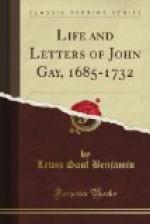It is evident from Gay’s “Epistle to the Right Honourable William Pulteney, Esq.” (published in 1717) that the party stayed some while at Paris, for therein is an account of that city, an account in which the author betrays a sad insularity; and he was certainly at Aix in November. “I should not forget to acknowledge your letter sent from Aix. You told me that writing was not good with the waters, and I find since, you are of my opinion, that it is as bad without the waters. But, I fancy, it is not writing, but thinking, that is so bad with the waters; and then you might write without any manner of prejudice if you write like our brother poets of these days.” Pope wrote to him on November 8th: “... That Duchess [of Hamilton],[19] Lord Warwick, Lord Stanhope, Mrs. Bellenden, Mrs. Lepell, and I cannot tell who else, had your letters ... I would send my services to Mr. Pulteney, but that he is out at Court, and make some compliment to Mrs. Pulteney, if she was not a Whig."[20]
From this letter it is evident that Gay was becoming well known in fashionable circles, and it is also clear that he had friends in the Court circle. “Gay is well at Court, and more than ever in the way of being served than ever.... Gay dines daily with the Maids of Honour,” Pope had written to Martha Blount in December, 1716; and Gay, who would rather have had a place in the Household with nothing to do and no responsibility than anything else in the world, was not the man to refrain from endeavouring to improve the occasion. Mrs. Howard he had first met at Hanover, and in London contrived to turn the acquaintanceship into friendship. Knowing Gay’s character and his ambition, it is probably doing him no injustice to say that he was first drawn to the lady by the belief that she might further his aims. However, it is only fair to say that he soon came to like her for herself, and long after he was convinced that she could be of no service to him he remained a very loyal and intimate friend. He was taken entirely into her confidence, as will presently be seen, and she even called him in to assist her when she was conducting an elaborate and stilted epistolatory flirtation with Lord Peterborough. It was most probably she who introduced him to Mrs. Bellenden, Mrs. Lepell, and the other ladies of the Court. Of Mrs. Howard and Gay, Dr. Johnson wrote: “Diligent court was paid to Mrs. Howard, afterwards Countess of Suffolk, who was much beloved by the King and Queen, to engage her interest for his promotion; but solicitations, verses, and flatteries were thrown away; the lady heard them and did nothing.” This, however, is manifestly unfair, for it is now known that Mrs. Howard’s influence was negligible.




